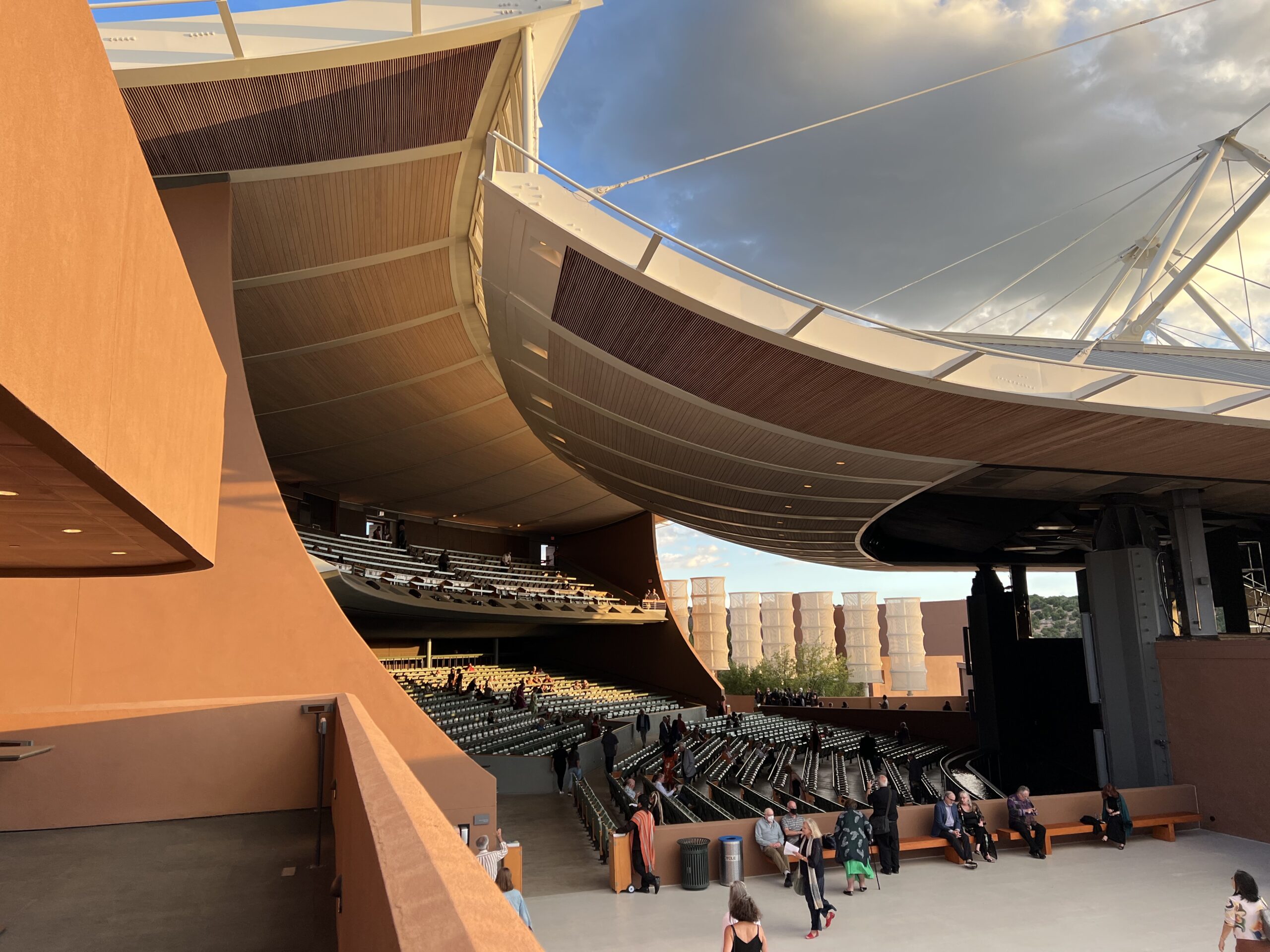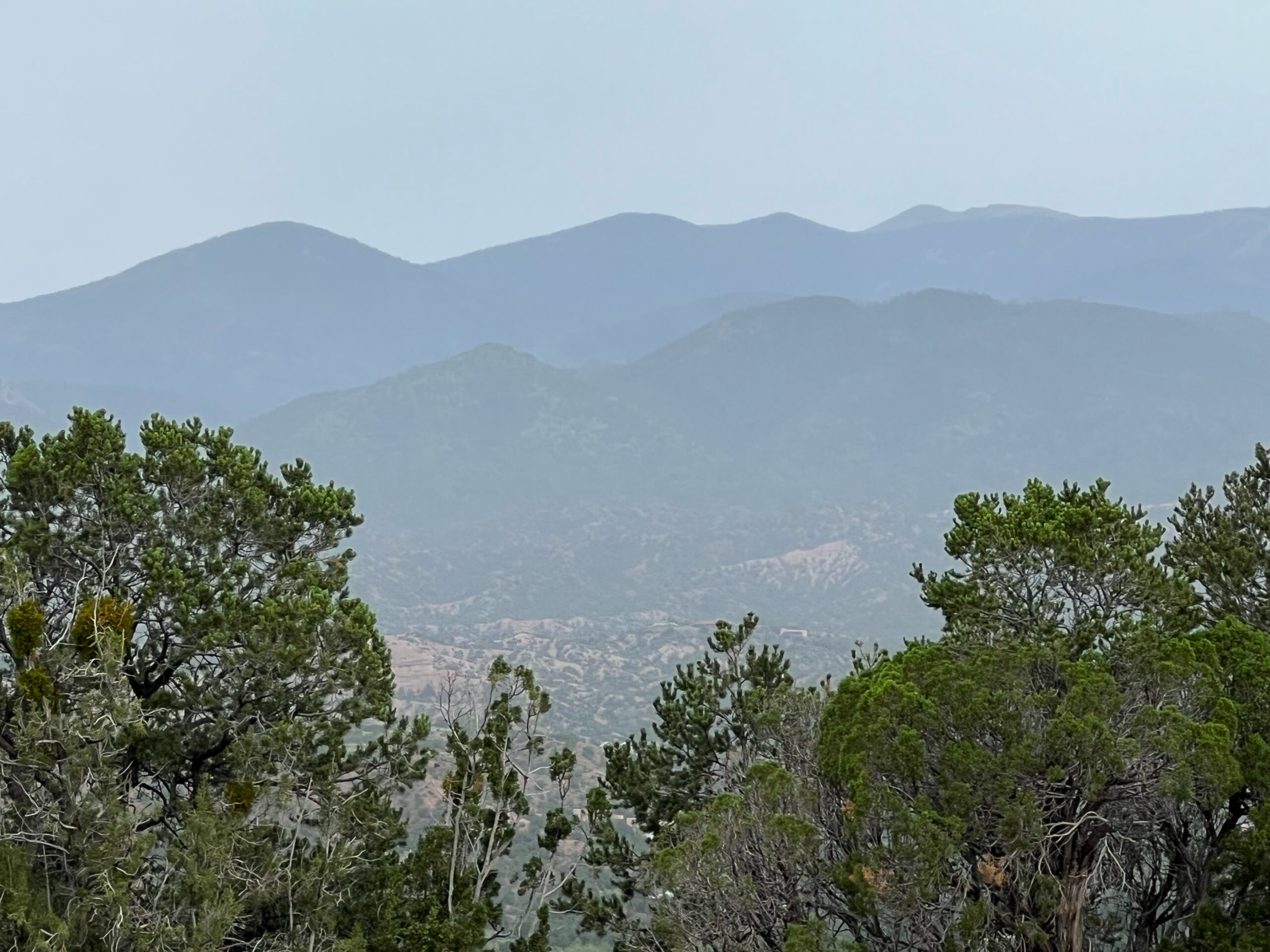By Jack McCord
The mere mention of Santa Fe conjures up images of brilliant blue skies, warm temperatures, clean, dry air, and adobe structures that blend into the landscape. The capital of New Mexico is also the third-largest art market in the country, ranging from painting and sculpture to impeccable Native American pottery and finely made jewelry, all from contemporary to antique and much of it very high quality.
At the same high level, there’s also a bit of music in town that has drawn people for decades.
The very idea of starting an opera company in Santa Fe confounded by John Crosby’s family and colleagues in the early 1950s. But the founder of the opera persisted and prevailed, with help from his prosperous family and his New York music world connections, to create a venue for young American singers. They would learn and perform a broad repertoire along the model of the European festivals which then held sway – and that were getting all the attention. He chose a quintessentially American venue, the mountain desert. In a brilliant stroke, Crosby cannily invited Igor Stravinsky for a residency in the second season, thus buying enormous credibility for his start-up company. He essentially invented the full range of an apprentice system, hiring at modest wages but with housing and transportation included, budding singers, technicians, costumers, wig makers, electricians, carpenters and all the roles necessary to mount an opera. The apprentice singers became the well-rehearsed chorus. Successful careers in all these domains were subsequently launched from Santa Fe. And many world and American premiers have graced this desert stage since, all part of Crosby’s original design. And were it not for generous, visionary locals and Los Alamos scientists, who formed the initial core of audience and donors, the fledgling opera company might never have survived.
From this hotbed of creativity and artistry, wonderful outcomes can result. Little wonder, with the likes of Harry Bicket as the Opera’s excellent Music Director. So it was with a great sense of joy and relief that the company held its first post-Covid full five-production season in July and August. It was a season which again included the usual master classes, apprentice auditions for managers and agents, pre-performance dinners and opera-sponsored events for donors and patrons. These are just part of what makes the Santa Fe Opera so special. Fresh from a marvelous master class with Susan Graham and Paul Groves as a duo (open to donors), you could browse in the opera shop, book a pre-performance dinner on the campus or shop for your pre-opera tailgate, take an art gallery stroll, enjoy the show, and then hasten home or back into town for a nightcap. All under the big New Mexico sky.
John Crosby started his desert project, with the help of friends and engineers, by setting off cannons on the former dude ranch his family had bought, to find just the right acoustical draft for an outdoor opera theater which initially was open to the sky. The placement of the stage has not changed since then, despite a devastating fire in the 1960s and two theater expansions. The back of the stage is often left open for a glimpse of an O’Keeffe sunset over the Jemez mountains, which can augment the scenery and help set a certain mood. Often that mood seems to be simply ‘Santa Fe’. One year, a forest fire in the distance reddened the scene, perfect for that evening’s Faust.
And while the theatre is now completely roofed it remains open on the sides so mountain breezes and rainstorms can keep you refreshed – so much so that even the most smartly-heeled patrons bring blankets and shawls in case the temperature falls. Silver Navajo jewelry worn on a black dress makes sense here like nowhere else. Climate change means that on some evenings in recent years the theater can stay warm, for the days can be hot. But the traditional pattern is to settle in for the first act in warmth with the sunset and end the evening well-swaddled against the chill, which can drop into the 50s. Occasionally, Mother Nature adds her own drama and a storm will fall perfectly timed with the narrative on stage – think the gales in Peter Grimes or lightning for the Queen of the Night. The New Mexico monsoon season ran this year from late June through August, and everyone has been very grateful given the beastly hot and fire-ridden late spring and early summer. Precipitation is something New Mexicans rarely complain about unless you are one of the very unfortunate folks who live in or near the forest fire burn scars from earlier this year and are now coping with mudslides and floods. This year, my artist friend tells me she’s never seen the like of the second bloom on her roses or the amazing height of her sunflowers. The apricot trees surrounding her charming adobe house are heavy with fruit. She’s now waiting for her Cosmonaut tomatoes to reach their peak before the aspen trees turn the mountainsides golden, come the fall.
Santa Fe presented five operas this season. The casts, all strong, were peppered with familiar names with Lyric Opera and Chicago connections. For particulars on the artists, too numerous to delve into here, I direct you to the Santa Fe Opera website.
This summer, beginning with a confusingly staged and conceived Carmen as the season opener, albeit with a cast that sounded great on paper, things looked up from there. The Barber of Seville was funny and slapstick, as such a Rossini opera should be, with superb singing and conducting. Lyric Ryan Center alums Emily Fons and Joshua Hopkins sang up a storm along with the rest of the cast, with no need for Mother Nature’s contribution that evening. Falstaff featured a lively cast and direction and never lagged, putting a new, sympathetic perspective on the bawdy knight as the central character, who was beautifully portrayed by Ryan alum Quinn Kelsey, aided and abetted by fellow alum Eric Ferring. A last-minute change of conductor had upped the ante considerably. The world premiere of M. Butterfly delivered astounding performances and direction, based on a hugely successful Broadway play which was in turn based on a true story. Northwestern alum Kangmin Justin Kim was perfect in the role of Song Liling. Perhaps the highlight for many, and certainly for all the Wagner Society patrons in the house, was Santa Fe’s premier Tristan and Isolde with a first-rate young cast and superb conducting by James Gaffigan. The audience cheered Ryan alums Tamara Wilson and Jamie Barton as well as Lyric stalwart Eric Owens (I saw it with his cover, David Leigh, who acquitted himself very ably). The production was the subject of much music world talk over the last three years since its announcement, in a ‘should they or shouldn’t they’ tone – for example, would the enlarged orchestra fit into the pit? Would it run too long at four and a half hours? How would the singers do in such a marathon at 7,200 feet? And so forth. In the end, the simple sets were brilliantly lighted and moved the story forward, as did the pacing and sheer beauty of the singing and orchestra. Those worried about sitting through a long Wagner piece would change their minds after seeing this Tristan, for it was a triumph. Some Santa Fe friends saw it three or four times. I did not want it to end.
Despite the seemingly esoteric and grandiose nature of the opera art form, in Santa Fe there’s little tra-la-la. In this wonderfully accessible cultural community, you can have great conversations with well-known artists, directors and conductors and, heck, even buy them a drink. In that vein, intervals and intermissions are great occasions for amateur and professional alike to discuss the artists and productions, much as football fans passionately talk over plays and bridge players argue over rival systems. Or you can simply look out on the mountains or the starry skies and take in all the scenery, with the music you’ve just heard ringing in your memory.
Santa Fe offers so much great music and art condensed into a summer season it can be frankly staggering. But who would want to miss Lyric veteran Susanna Phillips, with Lyric’s Craig Terry at the keyboard, performing for the Chamber Music Festival? Or for that matter, anything Performance Santa Fe presents, where the new Executive and Artistic Director is Chicago’s own Amy Iwano. The Desert Chorale, the Santa Fe Symphony (now headed by another former Chicagoan, Emma Scherer) and the Lensic Theatre series form just a partial listing of the bounty offered, much of it presented year-round. Throw into the mix the Spanish Market, the Ethnographic show and the world-famous Indian Market for starters, and you get the picture.
Cerulean morning skies, patio dinners, gorgeous sunsets and superb summer produce are the order of the day in Santa Fe. It’s Hatch green chili roasting time and the scent wafts all through town. But that’s another story to tell.














